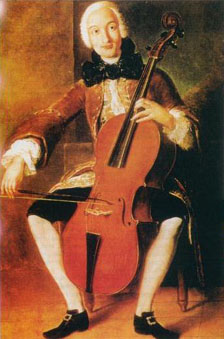| Luigi Boccherini  AKA Luigi Rodolfo Boccherini AKA Luigi Rodolfo Boccherini
Born: 19-Feb-1743
Birthplace: Lucca, Italy
Died: 28-May-1805
Location of death: Madrid, Spain
Cause of death: unspecified
Remains: Buried, Chiesa di San Francesco, Lucca, Italy
Gender: Male
Race or Ethnicity: White
Sexual orientation: Straight
Occupation: Composer Nationality: Italy
Executive summary: Cello Concerto in B-flat Italian composer, son of an Italian bass-player, was born at Lucca, and studied at Rome, where he became a fine cellist, and soon began to compose. He returned to Lucca, where for some years he was prominent as a player, and there he produced two oratorios and an opera. He toured in Europe, and in 1768 was received in Paris by Gossec and his circle with great enthusiasm, his instrumental pieces being highly applauded; and from 1769 to 1785 he held the post of "composer and virtuoso" to the King of Spain's brother, the infante Luis, at Madrid. He afterwards became "chamber-composer" to King Frederick William II. of Prussia, until 1797, when he returned to Spain. He died at Madrid on the 28th of May 1805.
As an admirer of Joseph Haydn, and a voluminous writer of instrumental music, chiefly for the violoncello, Boccherini represents the effect of the rapid progress of a new art on a mind too refined to be led into crudeness, too inventive and receptive to neglect any of the new artistic resources within its cognizance, and too superficial to grasp their real meaning. His mastery of the violoncello, and his advanced sense of beauty in instrumental tone-color, must have made even his earlier works seem to contemporaries at least as novel and mature as any of those experiments at which Haydn, with eight years more of age and experience, was laboring in the development of the true new forms. Most of Boccherini's technical resources proved useless to Haydn, and resemblances occur only in Haydn's earliest works (e.g. most of the slow movements of the quartets in op. 3 and in some as late as op. 17); whichever derived the characteristics of such movements from the other, the advantage is decidedly with Boccherini. But the progress of music did not lie in the production of novel beauties of instrumental tone in a style in which polyphonic organization was either deliberately abandoned or replaced by a pleasing illusion, while the form in its larger aspects was a mere inorganic amplification of the old suite-forms, which presupposed a genuine polyphonic organization as the vitalizing principle of their otherwise purely decorative nature. The true tendency of the new sonata forms was to make instrumental music dramatic in its variety and contrasts, instead of merely decorative. Haydn from the outset buried himself with the handling of new rhythmic proportions; and if it is hardly an exaggeration to say that the surprising beauty of color in such a specimen of Boccherini's 125 string-quintets as that in E major (containing the popular minuet) is perhaps more modern and certainly safer in performance than any special effect Haydn ever achieved, it is nevertheless true that even this beauty fails to justify the length and monotony of the work. Where Haydn uses any fraction of the resources of such a style, the ultimate effect is in proportion to a purpose of which Boccherini, with all his genuine admiration of his elder brother in art, could form no conception. Boccherini's works are, however, still indispensable for violoncellists, both in their education and their concert repertories; and his position in musical history is assured as that of the most original and, next to Giuseppe Tartini, perhaps the greatest writer of music for stringed instruments in the late Italian amplifications of the older quasi-polyphonic sonata or suite-form that survived into the beginning of the 19th century in the works of Nardini. Boccherini may safely be regarded as its last real master. He was wittily characterized by the contemporary violinist Puppo as "the wife of Haydn"; which is very true, if man and woman are two different species; but not as true as e.g. the equally common saying that "Schubert is the wife of Beethoven", and still less true than that "Vittoria is the wife of Palestrina."
Father: Leopoldo Boccherini (musician, d. 1766)
Mother: Maria Santa Prosperi
Wife: Clementina Pelicho (five children)
Wife: Joaquina Porreti (m. 1787)
Is the subject of books:
Luigi Boccherini: His Life and Work, 1965, BY: Germaine de Rothschild
Do you know something we don't?
Submit a correction or make a comment about this profile
Copyright ©2019 Soylent Communications
|